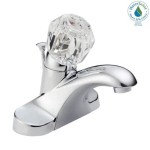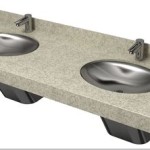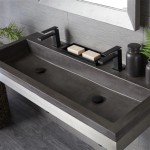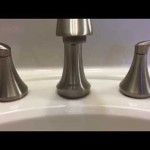Maintaining the Pristine Condition of Your Bathroom Vessel Sink Wash Tub: A Comprehensive Cleaning Guide
Bathroom vessel sinks offer a unique aesthetic appeal, elevating the visual interest of any bathroom space. Their exposed design, however, makes them more susceptible to accumulating soap scum, water spots, and grime. Maintaining a clean vessel sink wash tub requires consistent effort and the right cleaning techniques. This article provides a detailed guide on how to effectively clean your vessel sink, preserving its beauty and extending its lifespan.
Understanding the Materials and Choosing the Right Cleaning Products
Vessel sinks are manufactured from a variety of materials, including ceramic, porcelain, glass, stone, copper, and stainless steel. The appropriate cleaning method depends significantly on the material composition of the sink. Using the wrong cleaning product can damage the surface, leading to etching, scratching, or discoloration.
Ceramic and Porcelain: These are among the most common materials for vessel sinks. Their durable, non-porous surface allows for the use of a wider range of cleaning products. Mild dish soap and warm water are often sufficient for routine cleaning. For tougher stains, a non-abrasive bathroom cleaner specifically designed for ceramic and porcelain can be utilized. Avoid using abrasive scrub brushes or scouring pads, as these can scratch the surface. Instead, opt for a soft cloth, sponge, or microfiber cleaning pad. A solution of baking soda and water can also be effective for removing stubborn stains. Apply the paste to the stain, allow it to sit for several minutes, and then gently scrub with a soft cloth before rinsing thoroughly.
Glass: Glass vessel sinks are particularly susceptible to water spots and soap scum. Regular cleaning is crucial to maintain their clarity. Use a glass cleaner specifically formulated for bathroom fixtures. A solution of equal parts white vinegar and water can also be effective. Spray the cleaner onto the surface and wipe clean with a microfiber cloth. For stubborn water spots, a paste made from baking soda and water can be gently applied and then rinsed away. Always avoid abrasive cleaners and scrub brushes, as they can scratch the glass surface. A squeegee can be used after each use to minimize water spots.
Stone: Stone vessel sinks, such as those made from marble, granite, or travertine, require special care due to their porous nature. Avoid using acidic cleaners, such as vinegar, lemon juice, or ammonia, as these can etch the stone. Use a pH-neutral cleaner specifically designed for natural stone. Apply the cleaner to a soft cloth and gently wipe the surface. Rinse thoroughly with water and dry with a clean cloth. To prevent stains, seal the stone sink regularly with a stone sealant. This will create a protective barrier against water and other liquids.
Copper: Copper vessel sinks offer a unique, rustic aesthetic. They develop a patina over time, which some owners find desirable. However, if you wish to maintain the original shine, regular cleaning is necessary. Use a copper cleaner specifically designed for bathroom fixtures. A solution of mild dish soap and warm water can also be used for routine cleaning. Avoid using abrasive cleaners, as they can scratch the copper surface. To prevent water spots, dry the sink thoroughly after each use. A copper wax can be applied periodically to protect the surface and enhance its shine.
Stainless Steel: Stainless steel vessel sinks are durable and resistant to corrosion. However, they can still accumulate water spots and fingerprints. Use a stainless steel cleaner specifically designed for bathroom fixtures. A solution of mild dish soap and warm water can also be used for routine cleaning. Wipe the surface in the direction of the grain to avoid streaks. Avoid using abrasive cleaners, as they can scratch the stainless steel surface. A stainless steel polish can be applied periodically to enhance its shine.
Implementing Effective Cleaning Techniques
Beyond selecting the appropriate cleaning products, mastering effective cleaning techniques is equally important for maintaining a pristine vessel sink wash tub. A consistent cleaning schedule, targeted stain removal, and preventative measures will contribute to the sink's longevity and aesthetic appeal.
Routine Cleaning: The frequency of cleaning depends on the usage of the sink. However, a general guideline is to clean the sink at least once a week. For high-traffic bathrooms, more frequent cleaning may be necessary. Simply wipe down the sink with a damp cloth or sponge after each use to remove any spills or splashes. This will prevent the buildup of soap scum and water spots. Once a week, use the appropriate cleaning product for your sink's material to thoroughly clean the surface. Rinse thoroughly with water and dry with a clean cloth.
Targeted Stain Removal: Despite regular cleaning, stubborn stains can still occur. Identifying the type of stain is crucial for selecting the most effective removal method. Hard water stains, often appearing as white or chalky deposits, can be removed with a solution of equal parts white vinegar and water. Apply the solution to the stain, allow it to sit for several minutes, and then scrub gently with a soft cloth or sponge. Rinse thoroughly with water and dry with a clean cloth. For soap scum, a solution of baking soda and water can be effective. Apply the paste to the stain, allow it to sit for several minutes, and then scrub gently with a soft cloth before rinsing thoroughly. Organic stains, such as those from makeup or hair dye, may require a specialized stain remover. Always test the stain remover in an inconspicuous area first to ensure that it does not damage the sink's surface.
Preventative Measures: Taking preventative measures can significantly reduce the need for intensive cleaning. Install a water softener to reduce the mineral content of your water, which will minimize the formation of hard water stains. Squeegee the sink after each use to remove excess water and prevent water spots. Use a liquid soap dispenser instead of a bar of soap to minimize soap scum buildup. Regularly clean the drain to prevent clogs and odors. Avoid placing harsh chemicals or abrasive materials on the sink's surface.
Cleaning the Faucet and Surrounding Area: The faucet and surrounding countertop area should also be cleaned regularly. Use a damp cloth or sponge to wipe down the faucet and countertop after each use. For tougher stains, use a mild bathroom cleaner. Pay attention to the areas around the base of the faucet and the edges of the sink, as these are prone to accumulating grime. Use a toothbrush to clean hard-to-reach areas. Rinse thoroughly with water and dry with a clean cloth.
Addressing Specific Issues and Maintaining Long-Term Cleanliness
Certain issues, such as hard water stains, persistent odors, and chipped surfaces, require specific attention and solutions. Implementing preventative measures and addressing these issues promptly will contribute to the long-term cleanliness and aesthetic appeal of your bathroom vessel sink.
Hard Water Stains: Hard water contains high levels of minerals, such as calcium and magnesium, which can leave behind unsightly stains on your vessel sink. As mentioned earlier, a solution of equal parts white vinegar and water can be effective for removing hard water stains. However, for particularly stubborn stains, a commercial hard water stain remover may be necessary. Follow the manufacturer's instructions carefully. To prevent hard water stains, consider installing a water softener or using a water filter. Regularly wipe down the sink with a damp cloth or sponge after each use to remove any mineral deposits.
Persistent Odors: Unpleasant odors emanating from the sink drain can be caused by a buildup of bacteria and debris. To eliminate odors, pour a cup of baking soda down the drain, followed by a cup of white vinegar. Allow the mixture to fizz for 30 minutes, then flush with hot water. This will help to break down any organic matter that is causing the odor. Regularly clean the drain with a drain cleaner to prevent clogs and odors. Avoid pouring grease or other oily substances down the drain.
Chipped Surfaces: While less common, vessel sinks can sometimes experience chips or cracks, particularly those made from ceramic or porcelain. Minor chips can often be repaired with a porcelain repair kit. Follow the manufacturer's instructions carefully. For larger chips or cracks, it may be necessary to replace the sink. To prevent chips and cracks, avoid dropping heavy objects onto the sink. Be careful when cleaning the sink to avoid accidentally bumping it with hard objects.
By adhering to these guidelines and implementing a consistent cleaning routine, individuals can preserve the beauty and functionality of their bathroom vessel sink wash tub, contributing to a more hygienic and aesthetically pleasing bathroom environment.
-(web).jpg?strip=all)
ᐈ Aquatica Lotus Blck Stone Bathroom Vessel Sink Buy Best S
.jpg?strip=all)
ᐈ Aquatica Solace B Wht Rectangular Stone Bathroom Vessel Sink Buy Best S
.jpg?strip=all)
ᐈ Aquatica Aurora Wht Oval Stone Bathroom Vessel Sink Buy Best S

Luxier Rectangular Bathroom Ceramic Vessel Sink Art Basin In White Cs 021 The Home Depot

Considering A Vessel Sink For Your Bathroom Read This First Toulmin Kitchen Bath Custom Cabinets Kitchens And Design Remodeling In Tuscaloosa Birmingham Alabama

Luxier Rectangular Bathroom Ceramic Vessel Sink Art Basin In White Cs 021 The Home Depot
.jpg?strip=all)
ᐈ Aquatica Solace Wht Oval Stone Bathroom Vessel Sink Buy Best S

Casainc White Ceramic Oval Bathroom Basin Vessel Sink Hywy 7146 The Home Depot

Utilitysinks Plastic 24 Freestanding Compact Utility Tub Sink For Work Laundry Room Garage Greenhouse Pet Wash Station White Target

47 2 In L X 18 9 W 4 7 H Silver Porcelain Rectangular Bathroom Sink Wash Basin With Solid Surface W1240dx57022 The Home Depot
Related Posts







